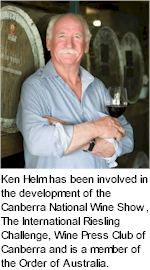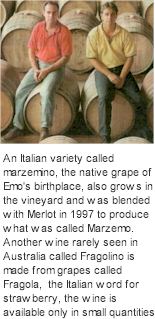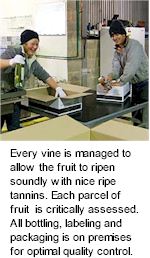| |
|
|

|
Route des Grands Crus represents the ultimate pilgrimmage for all cohorts of great red wine
It Passes Through Four Kilometres Of Gevrey Chambertin On either side can be found an archive of the most illustrious historical vineyards The invaluable Lieux-dits of Grand Cru Mazoyeres Chambertin are at the very beginning of the trek, on the right side of the Route as you enter from the south. There are only a few growers here but Domaine Dugat-Py remains first amongst equals, powerful and silken textured yet refined, only a few hundred bottles are made.
|
|
|
|

|
A big
Sweet And Savoury Style Of Blush Hued Wine Driven by revitalizing berry fruit flavours fashioned exclusively from Clare Valley Grenache. Ferments are arrested just shy of complete dryness to achieve a judiciously satisfying balance between natural Grenache sweetness and crisp, fruit laden acidity. Juicy strawberries up front, a zesty palate seasoned with spice notes and crushed dry herb. A whole lotta joy in a comely pink drink that pairs beautifully with prosciutto and tomato, a nicoise of rare salmon or just about any fresh pink fare.
|
|
|
|

|

THERE ARE GOOD REASONS WHY THE VISTA OF CLOUDY BAY DRESSES MARLBOROUGH'S MOST INTERNATIONALLY FETED SAUVIGNON BLANC. Originally named and charted by Captain Cook in 1770, Cloudy Bay lies at the very northeast of New Zealand's South Island, where the auspicious vines of Wairau Valley can catch a glimpse of the sea. The quality of fruit is without peer and the winemaking itself is second to none. A Sauvignon Blanc of intensity, cohesion and complexity, match with newly made gazpacho, shucked oysters and brewed moules Marinere.

A SINGLE VINEYARD CHENIN BLANC, sourced entirely from mature vines on the Kalleske farm, wild fermented and partially barrel matured to achieve an articulately varietal yet engagingly complex wine. Florentine gets her name from Caroline Florentine Kalleske, the first daughter of Johann Georg Kalleske who migrated to Australia from Prussia in 1838. Florentine is a true hand crafted wine that's been grown, vintaged and matured on the Kalleske estate farm, near the hamlet of Greenock in northwest Barossa.

A RICH ASSEMBLAGE OF CABERNET SAUVIGNON, Merlot and Cabernet Frank from Yin Barun Vineyard, Merlot from the Gralaine property near Geelong and Petit Verdot from Colbinabbin Estate at Heathcote. Hanging Rock Wines know about the noble French varietals, the estate patriarch has received French Australian Chamber of Commerce Flair Award for fostering French Australian relations. Hanging Rock's young French team have treated this complex cepage of fruit to a highly stylized vinification that's aimed at the modern Australian palate.

ONE REASON BRIAN STONIER FOUNDED HIS WINERY AND PLANTED VINEYARDS WAS HIS LOVE OF CHAMPAGNE. He originally established his now famous Pinot Noir vines to craft a luxury sparkling wine. Stonier Sparkling articulates the cool and maritime growing conditions of the Stonier vineyards at Mornington. Exhibiting heady aromatics, heightened flavour profiles of nuts and baked yeasts, with a fine effervescence, Cuvee Stonier expresses fine masculine fruit, in particular from the major component of Pinot Noir grown to cooler sites.
|
Helm is a
boutique cool climate winemaker, one of the first ever commercial operations in the Canberra region
Ken and Judith Helm started the vineyard, winery and cellar door in 1973 and have built it into one of the leading wineries in the Canberra District. It continues to be a family affair with all of the family (including recent additions) playing an integral part in the business. The winemakers are Ken Helm and daughter Stephanie, who are fourth and fifth generation descendants of German vinedressers from the Rhineland, who established vineyards near Albury and Rutherglen in the 1860s. Ken's flagship wines are Riesling and Cabernets and he has connections with Riesling makers from all over the world, eg: Dr Loosen and Katharina Prüm in the Mosel and Dr Alexander Kohen from the German Wine School in Koblez. Trips to the vineyards and wineries of Mosel, the Rhine valley and Bordeaux have fine tuned the Helm wines. In 2000 Ken instigated the Canberra International Riesling Challenge and his continuing role as chairman allows him to constantly keep abreast of new developments in Rieslings around the world.

Riesling has been Ken's passion for 30 years. The first wine he produced in Canberra in 1977 was Riesling and this won the winery's first show award. The next 30 years have seen some outstanding Rieslings produced at Helm wines, bringing over 50 awards and wine writer's rave reviews. Helm Wines has become renowned for its Classic Dry style of Riesling however recent years have seen the winery introduce a Half Dry style of Riesling which has a hint of sweetness. These two contrasting styles show the diversity that can be accomplished with this classic and often understated variety.
The winery uses a combination of modern and traditional winemaking equipment which allow for the consistent production of high quality premium range of reds and whites.Helm wines have attracted an impressive 30 years of wine show awards from every major show and wine critic in Australia.
Winemaker Ken Helm (AM) was appointed a Member in the General Division of the Order of Australia in the Australia Day 2010 honours. The award recognises Ken's service to the Australian wine industry as a winemaker, through the promotion of the Riesling white grape variety and as a supporter of cool climate wine producers and to the community of the Canberra/Yass region.
Wines of premium quality have been consistently produced for decades but Helm Wines is more than just a working winery. A visit to Helm Wines could not only involve wine tasting in the historic Toual School House, but also the trivia of wine, politics, history and perhaps a look behind the scenes on a guided tour of wine making (viticulture).
Cabernet Sauvignon, the classic red grape that thrives in the Canberra climate and soils. The wines have been a great success to Helm Wines. In 1984 the first gold medal and trophy to a Canberra wine was the 1983 Helm Cabernet Sauvignon. In 1988 the Helm Cabernet Sauvignon 1986 won the first gold at Royal Sydney Wine Show to a Canberra wine. In 1989 the move to blends saw the straight Cabernet Sauvignon cease production, except for Stephanie who produced her Cabernet sauvignon which in 1998 won gold and trophy at the Cool Climate Wine Show. The winery turned its attention back to Cabernet Sauvignon after a trip to Bordeaux Premium Growth wineries in 1999 by Ken, his son Matthew and grape growing neighbour Al Lustenburger. This trip assisted in the development of the recipe to make consistent premium Cabernets in the Canberra District. The award winning 2005 vintage was the first release using all the techniques of vine management and winemaking learnt in Bordeaux. The success of this vintage went far beyond all expectations, winning a silver medal in the London World Wine Awards and receiving praise from some of the top wine writers in Australia.
Michelini's is a
well-established award winning, family owned wine company located at the heart of the Alpines region in Victoria
In 1851 the Michelini's began growing grapes and making wine in the Trentino Alto Adige region of the Italian Alps. Emo Michelini arrived in Sydney in 1949 at the age of 25, and two years later with his wife Olga moved to the Buckland Valley where he began share-farming with several other Italian families, growing and curing tobacco. Looking for a source of fruit from cooler climates as blending material for their existing warmer sites, the Barossa based Orlando Wines approached Emo in the early 1980's and discussed the possibility of developing a vineyard in the region.

During the spring of 1982 Michelini's Vineyard was established by Emo Michelini and his sons Ilario and Dino. Perched in the Buckland Valley between the snow capped peaks of Mt Buffalo and the pristine crystal clear waters of Devil's Creek, the Alpine winters and cool summers nights characteristic of this secluded valley provide ideal conditions for maturing premium grapes. Emo acquired some the first varietal cuttings of Chardonnay and Pinot Noir from Orlando Wines, South Australia. With the majority of the vineyard obtaining river frontage and with the lime added to the soil to sweeten it, the fresh mountain air and the Alpine climate provided the ideal conditions to produce classic premium, cool climate wine. Merlot and Marzemino were planted along with further Chardonnay in 1991
Varieties planted are Chardonnay (16 Hectares), Pinot Noir (10 Hectares) and Merlot (10 Hectares). As well as the more mainstream varieties, Michelini have adapted traditional wine making techniques to produce the traditional Italian Pinot Grigio, Barbera, Sangiovese, Teroldego, Marzemino and Fragolino, as well as the sparkling white and red Fizz. Elevation is around 250 metres, with Chardonnay and Pinot Noir harvested for sparkling wines from late February to late March. Chardonnay ripens for table wine around late March, and Merlot early to mid April.
The vineyard is set to the Scott Henry trellis system, with 8 canes per vine on the more vigorous Chardonnay and Pinot Noir blocks and 4 canes per vine on the Merlot block. Moveable foliage wires contain shoots from the top cordon in an upright position whilst shoots from the bottom cordon are mostly allowed to fall down under their own weight. Leaf removal in the fruiting zone is carried out on Merlot to improve sunlight interception and on Chardonnay for sparkling wine to spread ripeness dates. Yield is regulated on the Merlot by removal of secondary shoots prior to flowering, and removal of excessive bunches per shoot at veraison. Target yield is around 12.5 tonnes per hectare.
While the industry has long recognised the region's suitability for producing premium fruit for sparkling wine, growing grapes in this district is not without its challenges and difficulties. Over time the vineyard has been developed to incorporate state-of-the-art equipment including Pellenc machine harvester and high technology spraying equipment which used in conjunction with the high skill level of the Michelini brothers and initiatives such as Integrated Pest Management (IPM) systems has resulted in strong risk management strategies.
Dino Michelini has a firm commitment that wine quality starts in the vineyard. The regional character is drawn from the Alpine Valley climate of cold winters and an extended summer of hot days and cool nights. He says that the main threat to vintage success is spring frosts, affecting the vineyard site in the Buckland River Valley. Frost protection is provided from two pumping stations on the bank of the Buckland River, supplying water to sprinklers across the entire vineyard. Through innovation in grape growing and wine making, the aim is to exceed the quality expectations in every bottle of Michelini's Wines.
The Cullen winemaking
approach is that they will do whatever it takes to make outstanding wines
In the early 1960's detailed climatic studies of various regions in Southwestern Australia revealed that during the winegrowing season, Margaret River's climate was similar to that of Bordeaux, particularly Pomerol. The conclusion that Margaret River was ideal for viticulture was first tested in Wilyabrup in 1966, when Diana and Kevin Cullen planted a trial acre of vines. The encouraging results led to the couple planting 18 acres of vines on their sheep and cattle farm in 1971.

Cullen Wines has since evolved into an estate specialising in quality wines from single vineyard sites. In his book 'Wisdom of the West' Bertrand Russell states that "Philosophy is as the Greeks put it a kind of adventure undertaken for its own sake." The philosophy of Cullen Wines is to search for the best quality expression of the vineyard in the wine.
The vineyard site at Cullens was carefully chosen for its potential to produce great wine, and in particular red wine. The maritime climate, rocky soils, dry farming, and organic practices all help to create individual and diverse winestyles which are unique to Cullen. Diana and Dr Kevin Cullen arrived in Busselton from Tasmania in 1948. They began to purchase land in the Margaret River region for farming purposes.
Studies carried out by renowned WA agronomist Dr. John Gladstones proved conclusively that Margaret River would be ideal for viticulture and particularly the production of quality wine. Dr Kevin Cullen and his wife Diana first tested this notion by planting a trial acre of vines in 1966. It was to mark the beginning of Margaret River as a wine region. Kevin and Di were so pleased with the results of the trial that they planted 18 acres of vines on their sheep and cattle farm. These initial varieties were Cabernet Sauvignon and Riesling - being the only varieties they were able to source.
The soils at Cullen are old, granite and gravely sandy loam, overlaying lateritic subsoils. The vines are dry farmed, helping to ensure maximum fruit quality, and are both pruned and harvested by hand. Low yields enable the flavours of the grapes to develop fully. The Cullen family philosophy is to put quality before quantity. Quality starts in the vineyard where the vines are dry farmed. Cullen Estate Vineyard has "A" Grade Biodynamic Certification with the Biological Farmers Association.
Cullen follows the maxim that great wines are made in the vineyard. Thus, prior to planting, extreme care is taken in choosing the best possible site.
The Gracebrook brand
has evolved from the passion David and Rhonda Maples have for the land and what it has to offer
David and Rhonda acquired very early in life the horticultural skills that would later become invaluable when applied to the vineyards of Gracebrook. Both being from farming backgrounds, Rhonda's parents owned and operated a dairy farm here in the King Valley, across the road from what is now their home farm. During Rhonda's holidays and weekends she would work in the local vineyards, either handpicking fruit or pruning vines. David's parents also owned and ran dairy farms as well as growing beef cattle, pigs and later on growing tobacco on a small farm located at Edi. This is when David left school and started farming with his parents.

Gracebrook Vineyard stands in front of the cellar door on an overlay of volcanic red basalt soils, terra rossa. There are some 12 acres (5ha) of vines divided into two separate irrigation blocks to cater for the varying depth of the basalt soil. The original site had a long history of being one of the premium farms of the King Valley. The narrow gauge goods trains that ran from Whitfield to Wangaratta from 1899 until 1952, stopped regularly at the Jarrott siding to collect the produce.
The founding Jarrott family placed the farm on the market in late 1997. This David Maples saw as a tremendous opportunity and exciting challenge. During the next two years, some 75 acres of vineyards were planted on the property along with all supporting infrastructure, from rebuilding and enlarging dams for both stock and irrigation water to fencing and road and track improvements on the property. Years were spent building stockyards and upgrading pasture in the grazing paddocks.
The Gracebrook Stables have been at the heart of the property since the 1880s. Built from local stringybark, red and yellow box round timbers, using traditional bush carpentry methods of the period in its construction. Although in good condition when acquired by the Maples, having withstood the test of time, the stables presented many challenges to David and Rhonda who took on the duty of restoring it back to its former glory.
There is no doubt that the King Valley is blessed as a location for grape growing. Gracebrook have been able to match varieties to separate sites to maximize the potential of the Valley. Fresh aromatic Riesling, rich fruity Merlot, Shiraz, Cabernet Sauvignon and spicy Sangiovese all reflect the fruit-driven wine style for which the King Valley has become famous. Traditional winemaking techniques ensure that quality is uncompromised, varieties retain their ripe berry characters and rich soft structures.
The original block of Chardonnay was first planted in 1989 on the fertile river flat paddock of the home farm. The first vintage of grapes were sold to Baileys of Glenrowan and subsequent vintages to large corporate companies. In 1994, David produced a small batch of Chardonnay. He entered it into The King Valley Shed Wine Show, winning in its class for best chardonnay. The Peipers Lane Shiraz paddock was purchased by David and Rhonda in 1995. This particular 56 acres of land had been neglected for a number of years and presented challenges in the control of blackberry, bracken fern and vermin. As they cleared the land and proceeded to sow it to pasture the farm revealed the deep well-drained red basalt soils. This with the northern aspect of the block, the abundance of water to be found in the little creek at the foot of the slope, all inspired this to become what is now known as the Shiraz Block. High quality French oak barrels are used for both Chardonnay and the red varieties.
|